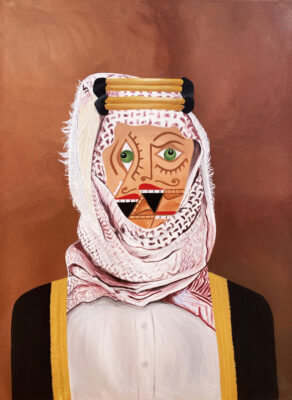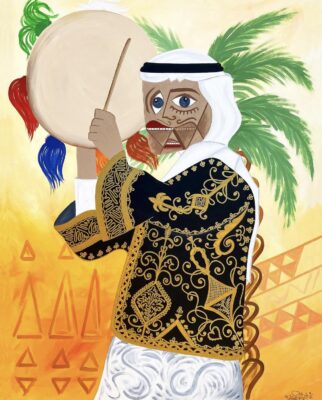Representing culture differently: this is Faisal Alkheriji’s calling, to paint original characters while blending different schools of art such as cubism and surrealism. Interview with the smiling Jeddah-based and Picasso-inspired artist.
Monopoly in Saudi Arabia
“Growing up in Jeddah is amazing, it’s my favourite city. It wasn’t the most advanced city, but it developed a lot in recent years to become, I believe, one of the most beautiful cities. It’s very chilled, cozy, people here are very friendly. I had a very normal childhood: I played everything from video games to soccer. I remember I used to play chess a lot, but the game I played the most other than video games was Monopoly. I loved it! With my cousins we used to stay five, six, ten hours playing one game! That was the business side of me, who was interested in the money part, the building part, the land and real estate.”
Artistic beginnings
“I wouldn’t say I was very artistic in my childhood. But when I was 6, I went to a summer camp where we used to paint. I believe that sparked my interest in art. Since then, I was always sketching and in 2007-8, I was around 16 years old, I started buying canvases and painting with colours. I then started copying an artist called Michael Godard. He was, and still is, one of my favourite artists. He used to paint very surreal scenes around Martini, the drink: the strawberries and olives would have arms and legs, it was like people, coming to life! It was very intriguing to me.
When being interviewed about his art, Michael Godard used a slogan, and to this day I say it to anyone who asks me for any advice on art, because I think it’s the best: “There’s no right or wrong way to do it“. When it comes to art you just do whatever you feel like. And that’s what I did, I started copying his paintings. Then I got into George Condo, who is a famous surreal artist, and obviously, Picasso is the godfather of painting.

Gahwa Shower (2016) and The Queen (2014) – © Faisal Alkheriji
After some time, I thought: I want to stop copying and start painting something for myself. So I chose a Michael Godard painting, the one with the strawberry taking a shower with a champagne bottle. I did it with a coffee and date: it was a date having a coffee shower. Then I chose a George Condo painting, “The Queen”. I added some Arabic letters to her dress and that’s it! It was basic customisation of their work, trying to mix it with my culture, and that’s what got me into the cultural part.
With time, I started getting into learning about my culture, seeing the beauty of it, the outfits, the regions, the traditions, I fell in love with it. If I paint even 10 years from now, I’m not going to finish covering all of its aspects!”
The toolbox
“I focus on painting. I tried to get into digital art, but I did not find joy in it, because there’s nothing like an actual brush and colours. It takes out the joy of actually mixing colours and coming out with a special one in every painting, which I love. Sculptures, I have not tried yet but I would love to, it’s one of the things I’m very interested in.”
“Theeban”, or the secret of the headscarf

Theeban 2020 – © Faisal Alkheriji
“Picasso is a huge inspiration to me, associating it with culture is something that I wouldn’t say was planned. It came along trying and mixing different styles of art, just experimenting what I love and enjoy.
“Theeban”, is a man wearing a “meshlah” (headscarf), however the “shemagh” (red and white headscarf) is placed in a different way from what you would normally see. Usually it’s worn either straight down, the professional way, or on the back, right or left.
The specific style of placement that I drew was inspired by a picture of King Abdulaziz, who was wearing it this way. That picture was placed behind King Salman on his first speech, during the period where he was referring to challenges.
Placing this painting behind him with this style of “shemagh” was a statement by King Salman meaning that he was is ready for tough times, whether it’s war, whether it’s something like Covid or anything else.
The word “theeban” is actually a slang word we use in Saudi to call someone brave, helpful, supportive, who’s got your back in tough times. It is inspired by the word “theeb”, which means wolf.”
A thirst for culture
“I realised I wanted to show my culture through art when this question popped up in my head: why did no one ever show me this or tell me about it? I found out that no one did, because not a lot of people knew about it. When I started looking for content related to culture, I could not find a lot. This was before the Ministry of Culture was created, which happened around 2015-16.

Farida (2020) – © Faisal Alkheriji
I didn’t choose to make it my mission, it just happened out of passion and love for its beauty. I was posting my older paintings without a lot of explanation, and I was getting many questions such as: what’s this outfit? What does it mean? I then started developing my captions into more educational content, where I tell the story behind it, the meaning, the cultural side of it.
My recent paintings focus a lot on traditional outfits. Every region has a specific pattern. Cultural habits like the “kashta” (camping in a tent), or playing “oud” for example, music or food. I have only covered the tip of the iceberg!
Creativity has no limits especially when you’re passionate about a topic that keeps you inspired all the time. So if I ever feel like I’m out of ideas, I just look at my culture again and I find inspiration there.”
The purple “red carpets” of Saudi Arabia
“The Sadu Lady” is a portrait of a lady dressed in a regular outfit with a veil and an “abaya” (long women coat), with “Sadu” patterns. “Sadu” pattern is from the central region of Saudi Arabia, which can be found everywhere, on cushions or tents: it is the best-known pattern of the Kingdom.

Sadu Lady 2021 – © Faisal Alkheriji
The colors of her “abaya” are the official ones: red, black, and white. The background is purple because recently, Saudi Arabia announced that the official carpet to welcome VIP guests from the Royal Court would be changed from red, which has been there forever, to purple. If you look at the King or Crown Prince Mohammed Bin Salman, they welcome their guests with that purple carpet.
Purple is coming from the lavender colour of the flowers in the desert. The Sadu pattern is on both sides. That’s why I did the background of this painting in purple, to match that carpet.
Then, the pink Sadu pattern that’s on the left-hand side is because I wanted to associate pink with purple, in an artistic touch of changing the traditional colours.”
Depicting “The Last Supper” for Ramadan
“As a twist to the very famous painting called “The Last Supper”, which had Jesus in the middle and many characters basically fighting over food, I did an Arabic version called “The First Fatoor”.

The First Fatoor (2020) – © Faisal Alkheriji
It depicts the same kind of setting, but set during first day of Ramadan, which is the holy month where Muslims fast from dawn till sunset, where all the family usually gathers to have breakfast. Even in the painting, you can find the Ramadan traditional patterns on the walls. The background shows the moon, meaning that Ramadan is here, and the table has all the Ramadan famous dishes that are only cooked during that time.”
Creativity hacks
“I can’t paint without music: to get in the mood, you need music! I shuffle music from Frank Sinatra to Umm Kulthum and then suddenly Kanye West, hip-hop, Jay-Z, J. Cole. I like a lot of different types of music. Then, I look at other artists’ paintings to be honest, even if their style is very different from mine. It doesn’t necessarily mean I want to do the same thing, but you always get inspired when you see someone creating a piece.”
Ongoing work

Ardha (2022) – © Faisal Alkheriji
“I am currently working on a few things. I have some requests for customisation from different clients. I’m making paintings related to culture. One would be – I don’t want to give spoilers but it’s never the same when I paint them than when I explain them! – the Saudi “ardha”, which is the very famous dance. I did a painting of it but it wasn’t very cubism-style thing. What I’m trying to do is a very cubist-style of “ardha”.
Another is a painting of a Saudi orchestra, representing all the musical instruments you would see in a Saudi or Arab band. All the Arabic instruments will be in a very cubist style, so I’m very excited about that!”
This interview has been edited for length and clarity.
Cover picture: The artist in his studio © Faisal Alkheriji
Find out more Instagram: @artbyfaisal Website: artbyfaisal.com Watch the video interview: https://youtu.be/fnTkUr8S0O0

